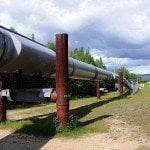The often-stated goal of becoming energy-independent could become a reality for the United States much sooner than anyone had previously dreamed, according to American oilmen. Drilling for oil and natural gas in the United States is booming, spurred by the new technologies that make horizontal drilling and fracking possible.

It is possible today to extract oil and gas from rock formations where it was once considered completely inaccessible. That combination of horizontal drilling and fracking technology was first tested and proven to work in 2003. After a few years, according to a market analyst who spoke to The Economist, the major oil companies got interested, and the number of horizontal wells operating in the US exploded, growing from under 2,000 to more than 45,000 by 2012.
What’s more, the new-found reserves in areas such as the Bakken formation in North Dakota are much larger than anyone had anticipated. Estimates now put the recoverable US natural gas reserves at 2,200 trillion cubic feet, and recoverable oil, both fluid and “tight,” at 223 billion barrels. That number includes potential offshore oil. As one analyst put it, the estimates keep changing as the technology improves and our understanding of how much of the resource can be accessed changes.
Combined with the rapid expansion in US production is an almost equally rapid decline in demand. This could mean that the US will not have to import oil and gas from anywhere outside North America, largely from Canada, to meet all its energy needs. The US itself is projected by the International Energy Agency (IEA) to become the world’s largest producer of oil by 2020.
With the US forecast to produce 8 million barrels a day by the end of next year, and with demand dropping by 2 per cent last year to 18.56 million barrels a day, the US will be in a position to import the shortfall entirely from Canada and Mexico within a decade. Canada’s production is forecast to grow to 6,5 million barrels a day.

































